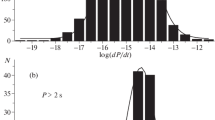Abstract
Known models proposed to explain the high space velocities of pulsars based on asymmetry of the transport coefficients of different sorts of neutrinos or electromagnetic radiation can be efficient only in the presence of high magnetic fields (to 1016 G) or short rotation periods for the neutron stars (of the order of 1 ms). This current study shows that the observed velocities are not correlated with either the pulsar periods or their surface magnetic fields. The initial rotation periods are estimated in a model for the magnetedipolar deceleration of their spin, aßsuming that the pulsar ages are equal to their kinematic ages. The initial period distribution is bimodal, with peaks at 5 ms and 0.5 s, and similar to the current distribution of periods. It is shown that asymmetry of the pulsar electromagnetic radiation is insufficient to give rise to additional acceleration of pulsars during their evolution after the supernova explosion that gave birth to them. The observations testify to deceleration of the motion, most likely due to the influence of the interstellar medium and interactions with nearby objects. The time scale for the exponential decrease in the magnetic field τ D and in the angle between the rotation axis and magnetic moment τ ß are estimated, yielding τ β = 1.4 million years. The derived dependence of the transverse velocity of a pulsar on the angle between the line of sight and the rotation axis of the neutron star corresponds to the expected dependence for acceleration mechanisms associated with asymmetry of the radiation emitted by the two poles of the star.
Similar content being viewed by others
References
Z. Arzoumanian, D. F. Chernoff, and J. M. Cordes, Astrophys. J. 289, 568 (2002).
T. Pribulla, S. M. Rucinski, W. Lu, S. W. Mochnacki, G. Conidis, R. M. Blake, H. DeBond, J. R. Thomson, W. Pych, W. Ogloza, and M. Siwak, Astron. J. 132, 769 (2006).
A. A. Loginov and I. F. Malov, Astron. Rep. 58, 733 (2014).
P. Arras and D. Lai, Astrophys. J. 519, 745 (1998).
M. Herant, W. Benz, W. R. Hix, C. L. Fryer, and S. A. Colgate, Astrophys. J. 435, 339 (1994).
A. Burrows, J. Hayess, and D. A. Fryxell, Astrophys. J. 450, 830 (1995).
D. Lai, D. F. Chernoff, and J. M. Cordes, Astrophys. J. 549, 1111 (2001).
D. Lai and Y.-Z. Qian, Astrophys. J. 505, 844 (1988).
E. R. Harrison and E. Tademaru, Astrophys. J. 201, 447 (1975).
S. A. Gerasimov, Yu. I. Neshpor, and A. A. Stepanyan, Izv. KrAO 65, 163 (1982).
D. R. Lorimer, M. Bailes, R. J. Dewey, and P. A. Harrison, Mon. Not. R. Astron. Soc. 263, 403 (1993).
R. N. Manchester, G. B. Hobbs, A. Teoh, and M. Hobbs, Astron. J. 129, 1993 (2005).
V. M. Malofeev, I. F. Malov, O. I. Malov, and A. P. Glushak, Astron. Rep. 47, 413 (2003).
Y. Sang and G. Chanmugan, Astrophys. J. 323, L61 (1987).
Yu. P. Pskovsky and O. F. Dorofeev, J. Astrophys. Astr. 11, 507 (1990).
E. Tademaru, Astrophys. J. 214, 885 (1977).
R. Manchester and J. Taylor, Pulsars (Freeman, San Francisco, 1977; Mir, Moscow, 1980).
I. F. Malov and E. B. Nikitina, Astron. Rep. 55, 19 (2011).
I. F. Malov and E. B. Nikitina, Astron. Rep. 55, 878 (2011).
Author information
Authors and Affiliations
Corresponding author
Additional information
Original Russian Text © A.A. Loginov, E.B. Nikitina, I.F. Malov, 2016, published in Astronomicheskii Zhurnal, 2016, Vol. 93, No. 2, pp. 149–159.
Rights and permissions
About this article
Cite this article
Loginov, A.A., Nikitina, E.B. & Malov, I.F. The space velocities of radio pulsars. Astron. Rep. 60, 193–203 (2016). https://doi.org/10.1134/S1063772916020062
Received:
Accepted:
Published:
Issue Date:
DOI: https://doi.org/10.1134/S1063772916020062




